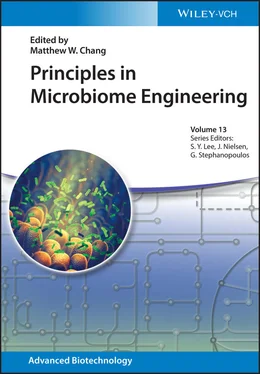Principles in Microbiome Engineering
Здесь есть возможность читать онлайн «Principles in Microbiome Engineering» — ознакомительный отрывок электронной книги совершенно бесплатно, а после прочтения отрывка купить полную версию. В некоторых случаях можно слушать аудио, скачать через торрент в формате fb2 и присутствует краткое содержание. Жанр: unrecognised, на английском языке. Описание произведения, (предисловие) а так же отзывы посетителей доступны на портале библиотеки ЛибКат.
- Название:Principles in Microbiome Engineering
- Автор:
- Жанр:
- Год:неизвестен
- ISBN:нет данных
- Рейтинг книги:5 / 5. Голосов: 1
-
Избранное:Добавить в избранное
- Отзывы:
-
Ваша оценка:
- 100
- 1
- 2
- 3
- 4
- 5
Principles in Microbiome Engineering: краткое содержание, описание и аннотация
Предлагаем к чтению аннотацию, описание, краткое содержание или предисловие (зависит от того, что написал сам автор книги «Principles in Microbiome Engineering»). Если вы не нашли необходимую информацию о книге — напишите в комментариях, мы постараемся отыскать её.
Provides an overview of the techniques and applications insight into the complex composition and interactions of microbiomes Principles in Microbiome Engineering
Principles in Microbiome Engineering
Principles in Microbiome Engineering — читать онлайн ознакомительный отрывок
Ниже представлен текст книги, разбитый по страницам. Система сохранения места последней прочитанной страницы, позволяет с удобством читать онлайн бесплатно книгу «Principles in Microbiome Engineering», без необходимости каждый раз заново искать на чём Вы остановились. Поставьте закладку, и сможете в любой момент перейти на страницу, на которой закончили чтение.
Интервал:
Закладка:
1.3.4.2 Neurodegenerative Diseases
Neurodegenerative diseases such as Parkinson's disease (PD) and Alzheimer's disease (AD) were found to be exacerbated by the disruption in gut microbiota, contributing to the pathogenesis of neurodegenerative disorders via the BGM [239, 257]. PD patients were reported to observe an increase in genus Lactobacillus, Bifidobacterium, and Akkermansia (pro‐inflammatory, mucin‐degrading Gram‐negative bacteria) population, and a decrease in the Faecalibacterium, Coprococcus, Blautia, Prevotella, and other microbes of the Prevotellaceae family (the bacteria responsible to SCFA production) [258, 259]. Dietary supplementation of specific probiotics, such as Lactobacillus and Bifidobacterium , was found to treat neurodegenerative symptoms in clinical trials and mice [260–262]. Phytochemicals, such as caffeine from ingested coffee and tea, were found to have an inverse relation, lowering the risk of developing PD. [263] It was also shown that caffeine confers neuroprotective properties in PD‐induced mice models [264, 265]. Similar to ASD, a ketogenic diet was identified to improve symptoms of PD and AD both in animal models and clinical trials [266–270]. These results indicate the role of diet in regulating the microbiota population involved in preventing neurodegenerative disease.
1.3.5 Metabolic Disorder
Metabolic disorders are caused by the dysbiosis of intestinal microbiota, resulting in changes in the host's ability to digest certain types of foods. This leads to various disease metabolic disorders such as obesity, diabetes, and non‐alcoholic fatty liver disease (NAFLD). In this chapter, we will discuss these metabolic disorders and their link to diet and the microbiome.
1.3.5.1 Obesity
The gut microbiota composition affects the host's ability to digest different types of food, thereby causing the host to metabolize the nutrients from the food itself. In 2004, a group determined that the gut microbiota regulates lipid storage in the human body [271]. Later in 2006, they found significant differences between the relative abundance of Bacteroidetes and Firmicutes in the GI tract of obese and lean mice. The study also reported that FMT of samples from obese mice to germ‐free mice resulted in the development of obesity pre‐symptoms [131]. The same research group further studied the GI microbiota from monozygotic and dizygotic twins with different weight groups (lean and obese) and discovered large variations in the gut microbiota despite having similar genetic makeup [45]. The research team then conducted FMT of microbiota from the identical twins into germ‐free mice. Groups provided with FMT from lean donors maintained normal weight, while groups treated with FMT from obese donors gained a significant amount of weight throughout the study [272].
The role of gut microbes in regulating fat storage in their human host is mainly attributed to the ability of these microbes to ferment complex polysaccharides that the host generally cannot absorb from the diet [273]. Microbes such as B. thetaiotaomicron have been shown to induce the expression of monosaccharide transporters in mice [274], where the polysaccharides are hydrolyzed into monosaccharides and SCFAs for easy absorption by the host intestinal cells. The increase of sugar uptake is then converted to lipids in the liver, triggering intestinal microbes to facilitate host expression fat metabolism gene Fiaf resulting in the accumulation of excessive fat [275]. Other studies have shown that orally introduced probiotics in mice fed with a high‐fat diet prevent the perturbation of intestinal mucosal permeability and limit energy absorption. These oral probiotics exert such bioactivity by reducing plasma LPS and cytokines and promote the gut secretion of glucagon‐like peptide‐1 (GLP‐1) and glucagon‐like peptide‐2 (GLP‐2) involved in maintaining the intestinal mucosal barrier [276].
1.3.5.2 Diabetes
Diabetes is a metabolic disorder that results in an increased sugar serum level, often resulting from the deficiency of insulin secretion or insulin insensitivity. Studies have shown that bacterial abundance in the gut has a strong correlation to the onset of diabetes. This has been shown in type II diabetes (T2D) patients that showed increased Firmicutes abundances with a proportional decrease in Bacteroidetes abundance. Long‐term observation of T2D patients undergoing weight loss showed a recovery of Bacteroidetes abundance and depletion of Firmicutes population [131]. It was discovered that the ratio of GI Firmicutes / Bacteroides affects the body metabolism, where patients with higher ratio were shown to be more susceptible to inflammatory responses, increased BMI, and a higher risk of developing insulin resistance that may lead to type 2 diabetes [271, 275, 277]. Certain studies indicated that orally administered prebiotics helps lower the ratio in hyperphagic, obese, and hyperglycemic mice model (ob/ob), which caused an increase in the number of L‐cells [278]. The increase of L‐cells raises the plasma levels of GLP‐1, triggering glucagon expression, resulting in leaner mice compared to the untreated groups.
1.3.5.3 Non‐alcoholic Fatty Liver Disease (NAFLD)
NAFLD is a metabolic disorder that results from the build‐up of liver fat in patients without a history of impaired liver function from heavy drinking, viral infections, or other liver diseases [279, 280]. NAFLD is the most common liver disease globally, with the number of patients increasing annually. Studies have found that the prevalence of NAFLD is linked to gut microbiota, where patients with liver failure often observe microbial overgrowth of small intestinal and are used as an indicator to determine the liver failure severity [281]. As discussed earlier, the ratio of Firmicutes / Bacteroides affects the host insulin resistance. On top of that, the ratio affects increasing endogenous ethanol production and inducing choline deficiency in the host increasing the risk of NAFLD development [282]. Ethanol produced by the microbiota increases intestinal mucosal permeability that coupled with choline deficiency, triggers the toll‐like receptors, which stimulate hepatocytes to produce plentiful cytokines involved in NAFLD pathogenesis [283].
Prebiotics and lactulose are commonly used to treat NAFLD enriching the Bifidobacterium abundance. Other prebiotics from the inulin‐type fructose fed to NAFLD animal models were shown to reduce the development of hepatic steatosis. These oligofructoses reduce fatty acid synthesis, promote weight loss by regulating intestinal polypeptides, reducing inflammation and proinflammatory cytokines, improving blood sugar regulation, and regulating intestinal microbiota [281, 284].
1.4 Challenges and Opportunities
1.4.1 Limitations in the Field
While we have observed great strides in microbiome research, there are many more aspects that would need further investigation. Currently, most studies focus on the effects of the single nutrient and its role in modulating microbiota. However, human dietary habits are complex, where synergistic effects of nutrients might need to be further investigated. Further, a larger cohort of long‐term human microbiome studies would be needed to map and predict the shift in the microbiome. This would include the role of dietary and socio‐economic impacts on the human host [96]. Additionally, further studies linking diet and daily activities would be needed. Studies suggest higher gut Shannon index in individuals who regularly exercise and practice good dietary habits compared to sedentary individuals [285]. Thus, further research would be merited to understand better the role of microbiome, diet, and human health.
Читать дальшеИнтервал:
Закладка:
Похожие книги на «Principles in Microbiome Engineering»
Представляем Вашему вниманию похожие книги на «Principles in Microbiome Engineering» списком для выбора. Мы отобрали схожую по названию и смыслу литературу в надежде предоставить читателям больше вариантов отыскать новые, интересные, ещё непрочитанные произведения.
Обсуждение, отзывы о книге «Principles in Microbiome Engineering» и просто собственные мнения читателей. Оставьте ваши комментарии, напишите, что Вы думаете о произведении, его смысле или главных героях. Укажите что конкретно понравилось, а что нет, и почему Вы так считаете.












